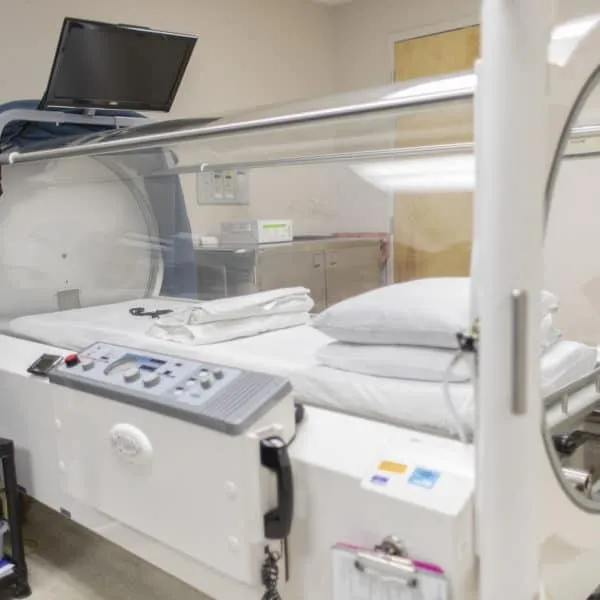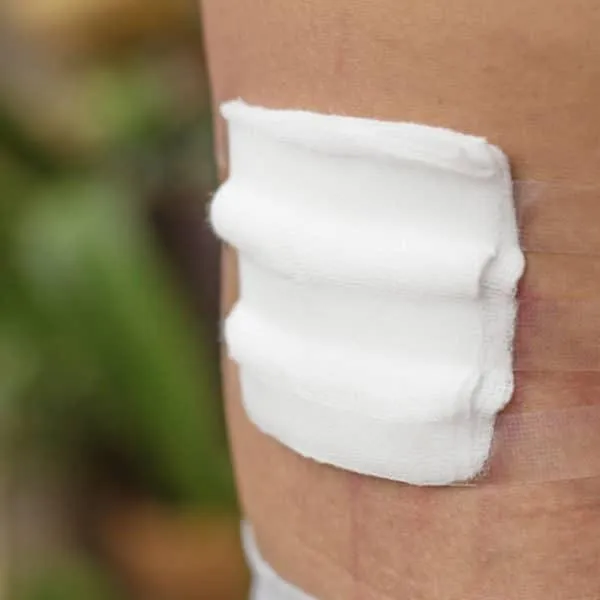Wound Care for Cancer Patients: Expert Treatment and Healing
Many cancers can cause a skin ulcer. These ulcers are called cancerous ulcers. Some chronic wounds can turn into cancerous ulcers. These include burns, radiation and venous wounds.
Find a Wound Care Center ® Near You
If you or a loved one is struggling with a wound that won’t heal, a Healogics Wound Care Center can help. Since there is no need for a referral, your treatment is only a click and call away.
Home»Diabetes and Wound Healing

Malignant and Atypical Wounds: Diagnosis and Treatment
What is a malignant wound? Many cancers can cause a skin ulcer. These ulcers are called malignant ulcers or cancerous ulcers. Some chronic wounds can turn into cancerous ulcers. These include burns, radiation and venous wounds. Malignant wounds require specialized care and attention to prevent further complications and promote healing. What is an atypical wound?…
Cancer Patient Resources

Hyperbaric Oxygen Therapy (HBO)
Hyperbaric oxygen therapy (HBOT) is a treatment that increases the amount of oxygen blood cells can carry. It has been used for more than 70 years to improve healing in tissues deprived of oxygen. Studies show it significantly improves healing for some types of chronic wounds.

Ulcer Wound Care: Best Practices for Optimal Healing
At Healogics, we know that managing a wound properly is essential for healing and preventing complications. More than 6 million Americans live with chronic wounds, significantly impacting daily activities, mobility, and overall well-being. Whether you’re caring for a diabetic foot ulcer, pressure injury, or another type of wound, following the right care procedures is vital…

How Long Does It Take for a Wound to Heal: What Every Nurse and Patient Should Know
Wound healing can be a tedious and complex process, often made more challenging by the many factors that influence recovery. Because of this, proper care is crucial for minimizing the risk of bacterial, viral, or fungal infections. Without necessary precautions and comprehensive knowledge, a shallow wound can turn into a persistent problem with various complications.
Whether you’re a nurse caring for a patient or someone managing their own wound, understanding the different stages of wound healing is crucial. This awareness will help you know when to seek professional intervention for quicker, safer results.
At Royal Wound Care, we’re committed to offering expert guidance and compassionate care. Therefore, in this post, we will discuss the healing process for wounds and key factors that can influence recovery. We will also explore the different healing stages, as well as share tips to prevent infection and promote faster healing.

How Long Does It Take for a Wound to Heal: What Every Nurse and Patient Should Know
Ultimately, wound healing times can vary depending on several factors. On average, minor wounds generally heal in three to seven days. Comparatively, major surgical incisions or chronic wounds can take several months to heal entirely.
Wound healing can be contingent on the individual’s immune system, the wound’s size and depth, blood flow to the area, and how well the wound is cared for. This is why, although complex, advanced wound treatments can be essential in promoting faster recovery and improving long-term outcomes.
Here are a few factors than can impact wound healing:

What Factors Affect Wound Healing?
Blood Flow and Oxygen Delivery
Blood vessels play a critical role in delivering red blood cells, oxygen, and nutrients to the wound site. Each component is essential for minimizing the risk of blood clots and helping wounds heal faster.
Wound Cleanliness and Infection Prevention
Keeping wounds clean doesn’t stop after the initial treatment. Proper wound care must continue at home in order to prevent infection and minimize long-term risk. A wound infection, however small, can significantly delay healing and cause complications that require immediate medical attention.
To learn more, visit “Caring for Your Wound.” Here you can find information on how to change dressing, where to store supplies, and how to help your wound heal.
Patient Health and Immune Function
The immune system plays a vital role in wound healing. More specifically, the white blood cells, called neutrophils, macrophages, lymphocytes, and eosinophils, regulate the wound site and support tissue regeneration. Conditions such as diabetes, malnutrition, and deficiencies can impair the process and slow healing.
Wound Type and Size
Superficial wounds, such as abrasions, lacerations, and puncture wounds, are generally quick to heal. These are wounds that experience minor or no bleeding, little pain, and minimal swelling.
Larger or deeper wounds, however, naturally take longer to heal. Because they often affect underlying tissues, these wounds may progress through additional or prolonged stages of the healing process.
Chronic Conditions or Comorbidities
Both chronic conditions and comorbidities can significantly impact wound healing. Conditions such as diabetes, cardiovascular disease, and COPD can reduce blood flow and nutrient delivery, therefore weakening the immune system. Rather than progressing through the healing process, wounds remain in a chronic inflammatory state.
Related: Edema and Diabetes and Slow Healing Wounds: Understanding Care

What Are the Stages of Wound Healing?
Wounds heal in distinct stages, each necessary to the overall recovery process. Understanding what to expect during each stage can help patients recognize when to seek professional guidance. Additionally, nurses that obtain proper knowledge can better care for each patients’ unique and dynamic needs.
Hemostasis
Hemostasis occurs directly after an injury occurs, when the body detects the sudden change and initiates the proper response. In this case, blood vessels constrict to stop the bleeding and platelets form a clot to create a temporary barrier.
Inflammation
The inflammation stage, where the immune system activates, occurs one to five days after the injury. Neutrophils clean the wound of bacteria to prevent infection, while the macrophages destroy pathogens and dead cells.
The wounded area may become red, swollen, and warm. This is a normal response as cytokines and chemokines draw immune cells to the wound. This is not yet a cause for concern, but rather a sign that the body is working to prevent infection.
Proliferation
During proliferation, several key processes work in tandem to repair the wound. Angiogenesis occurs as new blood vessels form while fibroplasia produces collagen and matrix components for structural support. These processes contribute to the formation of granulation tissue, a temporary layer that fills the wound and provides the framework for healing.
Maturation
The final stage of the process is maturation. This is where the wound strengthens and the new tissue forms, resembling the surrounding skin. The newer collagen (type III) is gradually replaced by a more durable alternative (type I), and vascular regression occurs. The healed wounds become scar tissue, which inevitably becomes less prominent over time.
How to Heal Wounds Faster
Efficient care can improve healing outcomes and reduce the risk of further complications. Here are evidence-based tips to help wounds heal faster:
Keep Wounds Clean and Moist
While caring for a wound, ensure that it remains clean and moist to promote migration. Doing so also prevents scabbing, which otherwise acts as a barrier for cell growth. Bathe daily with soap and water, following the guidance of your designated care provider.
However, keep the dressing clean and dry. If the dressing becomes wet or soiled, change it as quickly as possible.
Ensure Adequate Nutrition and Hydration
The proper diet and sufficient hydration are the building blocks for tissue repair. It is recommended that patients consume protein, vitamin A, vitamin C, and zinc for optimal healing. Nonetheless, the doctor or nurse will provide special dietary or fluid restrictions if necessary.
Manage Underlying Health Conditions
As previously discussed, certain health conditions and comorbidities can exacerbate the wound healing process. Common symptoms include a compromised immune response, diminished tissue perfusion, and increased susceptibility to infection.
When these conditions are properly cared for, the immune system works more effectively and therefore promotes quicker wound closure.
Consider Professional Wound Care
For complex or non-healing wounds, specialized services can provide expert interventions tailored to a patient's needs. Mobile wound care, for example, is an efficient way to bridge the gap between specialty wound care and comfortable healing.
Additionally, patients may require cutting-edge treatments, such as debridement, NPWT, and skin substitutes. Professionals with comprehensive knowledge are able to assess the severity and act accordingly.
Wound healing is influenced by various factors, many of which wound healing specialists can accurately diagnose, manage, and treat.
Wound healing is a complex, multi-stage process influenced by various factors, including lifestyle preexisting conditions and immune system function. By understanding the healing timeline, both patients and nurses can better support the body’s natural repair mechanisms. If you’re ever uncertain, contact the experts at Royal Wound Care. You aren’t just a case—you’re part of our community, and we’re here to support you through every step of the healing process.
If your facility is looking for trusted leaders in advanced healing, partner with us today! Experience lower infection rates, faster pressure ulcer healing times, and fewer wound-related hospitalizations. Healing is possible, you just need the right team to support you.
WEST HILLS
7230 Medical Center Dr. Suite 100
West Hills, CA 91307
(818)–660–2977
BEVERLY HILLS
9735 Wilshare Blvd #210B
Beverly Hills, CA 90212
(818)–660–2977
If you are interested in making an appointment, please click here to find a Wound Care Center near you.
Request an Appointment at a Royal Wound Care Facility near you.
Royal Wound Care is the expert in wound healing. Our board-certified wound care specialists are ready to help you begin your healing journey. Click the button below to request an appointment at a Wound Care Center near you—no referral needed
© 2025 Royal Wound Care, LLC. All rights reserved.
site by Growth Partners Marketing

